2017 KIA CARENS RHD fuel filter
[x] Cancel search: fuel filterPage 607 of 723
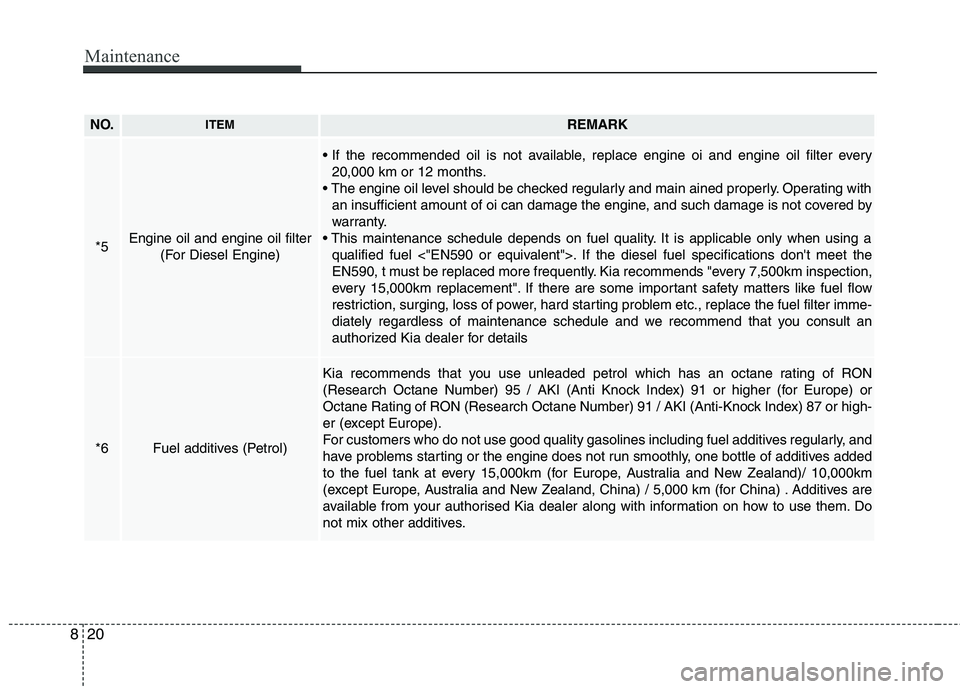
Maintenance
20
8
NO.ITEMREMARK
*5Engine oil and engine oil filter
(For Diesel Engine)
20,000 km or 12 months.
Operating with an insufficient amount of oi can damage the engine, and such damage is not covered by
warranty.
It is applicable only when using a qualified fuel <"EN590 or equivalent">. If the diesel fuel specifications don't meet the
EN590, t must be replaced more frequently. Kia recommends "every 7,500km inspection,
every 15,000km replacement". If there are some important safety matters like fuel flow
restriction, surging, loss of power, hard starting problem etc., replace the fuel filter imme-
diately regardless of maintenance schedule and we recommend that you consult an
authorized Kia dealer for details
*6Fuel additives (Petrol)
Kia recommends that you use unleaded petrol which has an octane rating of RON
(Research Octane Number) 95 / AKI (Anti Knock Index) 91 or higher (for Europe) or
Octane Rating of RON (Research Octane Number) 91 / AKI (Anti-Knock Index) 87 or high-
er (except Europe).
For customers who do not use good quality gasolines including fuel additives regularly, and
have problems starting or the engine does not run smoothly, one bottle of additives added
to the fuel tank at every 15,000km (for Europe, Australia and New Zealand)/ 10,000km
(except Europe, Australia and New Zealand, China) / 5,000 km (for China) . Additives are
available from your authorised Kia dealer along with information on how to use them. Do
not mix other additives.
Page 608 of 723
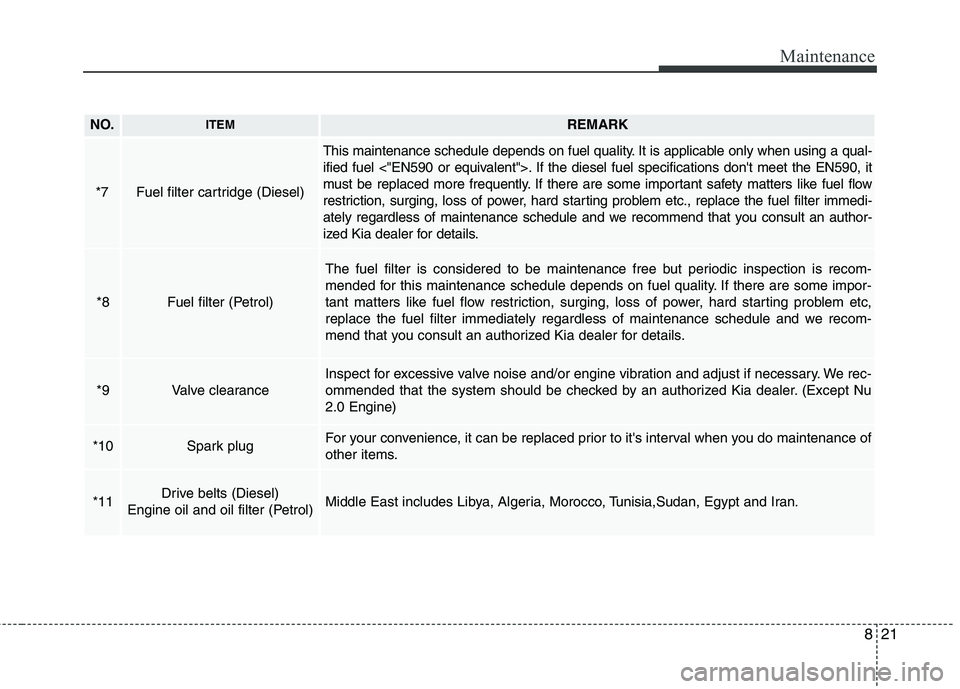
821
Maintenance
NO.ITEMREMARK
*7Fuel filter cartridge (Diesel)
This maintenance schedule depends on fuel quality. It is applicable only when using a qual-
ified fuel <"EN590 or equivalent">. If the diesel fuel specifications don't meet the EN590, it
must be replaced more frequently. If there are some important safety matters like fuel flow
restriction, surging, loss of power, hard starting problem etc., replace the fuel filter immedi-
ately regardless of maintenance schedule and we recommend that you consult an author-
ized Kia dealer for details.
*8Fuel filter (Petrol)
The fuel filter is considered to be maintenance free but periodic inspection is recom-
mended for this maintenance schedule depends on fuel quality. If there are some impor-
tant matters like fuel flow restriction, surging, loss of power, hard starting problem etc,
replace the fuel filter immediately regardless of maintenance schedule and we recom-
mend that you consult an authorized Kia dealer for details.
*9Valve clearance
Inspect for excessive valve noise and/or engine vibration and adjust if necessary. We rec-
ommended that the system should be checked by an authorized Kia dealer. (Except Nu2.0 Engine)
*10Spark plugFor your convenience, it can be replaced prior to it's interval when you do maintenance of
other items.
*11Drive belts (Diesel)
Engine oil and oil filter (Petrol)Middle East includes Libya, Algeria, Morocco, Tunisia,Sudan, Egypt and Iran.
Page 610 of 723

823
Maintenance
Normal Maintenance Schedule - Except Europe (Including Russia) (Continue)
MAINTENANCE INTERVALS
MAINTENANCE ITEMNumber of months or driving distance, whichever comes first
Months1224364860728496
Miles×1,0001020304050607080
Km×1,000153045607590105120
Valve clearance(Except for Nu 2.0 Engine) * 9Inspect every 90,000 Km (60,000 miles) or 72 months
Spark plugsPetrol - Iridium *10
Replace every 160,000 km (104,000 miles) or 120months
Petrol - NickelRR
Automatic transaxle fluid (if equipped)No check, No service required
Manual transaxle fluid (if equipped) * 3II
Dual clutch transmission fluid (if equipped) * 3II
Drive shafts and bootsIIII
Fuel additives (Petrol) *6Add every 10,000 km (6,500 miles) or 6 months (For Australia and
New Zealand : Add every 15,000 km (10,000 miles) or 12 months
Fuel filter (Petrol) * 8For China, BrazilIRIR
Fuel filter cartridge (Diesel) * 7RRRR
Fuel lines, hoses and connectionsPetrolII
DieselIIII
Fuel tank air filter (if equipped)PetrolIRIR
Vapor hose and fuel filler capPetrolII
Fuel filler cap (Diesel)DieselII
I : Inspect and if necessary, adjust, correct, clean or replace. R : Replace or change.
Page 615 of 723
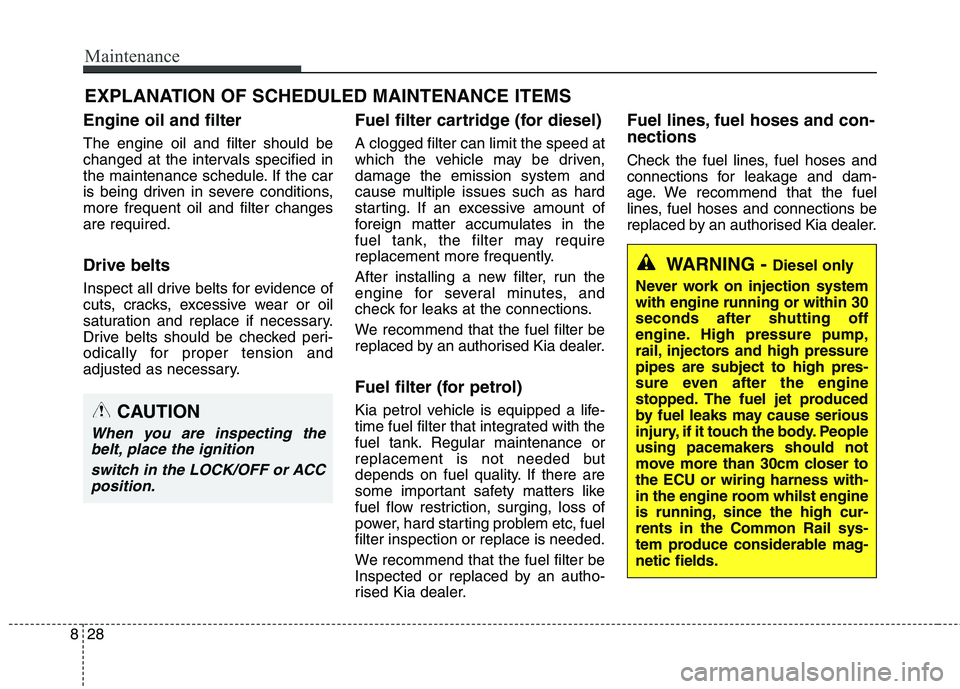
Maintenance
28
8
EXPLANATION OF SCHEDULED MAINTENANCE ITEMS
Engine oil and filter The engine oil and filter should be
changed at the intervals specified in
the maintenance schedule. If the car
is being driven in severe conditions,more frequent oil and filter changesare required. Drive belts
Inspect all drive belts for evidence of
cuts, cracks, excessive wear or oil
saturation and replace if necessary.
Drive belts should be checked peri-
odically for proper tension and
adjusted as necessary. Fuel filter cartridge (for diesel) A clogged filter can limit the speed at
which the vehicle may be driven,damage the emission system and
cause multiple issues such as hard
starting. If an excessive amount of
foreign matter accumulates in the
fuel tank, the filter may require
replacement more frequently.
After installing a new filter, run the
engine for several minutes, and
check for leaks at the connections.
We recommend that the fuel filter be
replaced by an authorised Kia dealer.
Fuel filter (for petrol)
Kia petrol vehicle is equipped a life-
time fuel filter that integrated with the
fuel tank. Regular maintenance or
replacement is not needed but
depends on fuel quality. If there are
some important safety matters like
fuel flow restriction, surging, loss of
power, hard starting problem etc, fuelfilter inspection or replace is needed.
We recommend that the fuel filter be
Inspected or replaced by an autho-
rised Kia dealer.Fuel lines, fuel hoses and con- nections
Check the fuel lines, fuel hoses and
connections for leakage and dam-
age. We recommend that the fuel
lines, fuel hoses and connections be
replaced by an authorised Kia dealer.
WARNING -
Diesel only
Never work on injection system with engine running or within 30seconds after shutting off
engine. High pressure pump,
rail, injectors and high pressurepipes are subject to high pres-
sure even after the engine
stopped. The fuel jet produced
by fuel leaks may cause serious
injury, if it touch the body. People
using pacemakers should not
move more than 30cm closer tothe ECU or wiring harness with-
in the engine room whilst engine
is running, since the high cur-rents in the Common Rail sys-
tem produce considerable mag-netic fields.
CAUTION
When you are inspecting the belt, place the ignition
switch in the LOCK/OFF or ACCposition.
Page 616 of 723
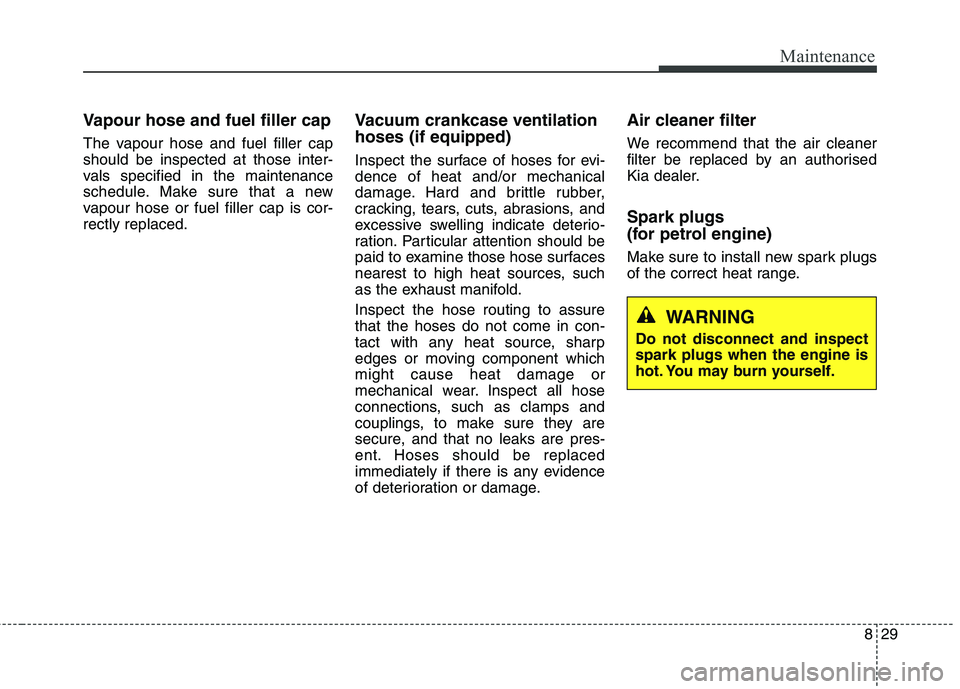
829
Maintenance
Vapour hose and fuel filler cap
The vapour hose and fuel filler cap should be inspected at those inter-
vals specified in the maintenance
schedule. Make sure that a new
vapour hose or fuel filler cap is cor-rectly replaced.Vacuum crankcase ventilation hoses (if equipped)
Inspect the surface of hoses for evi- dence of heat and/or mechanical
damage. Hard and brittle rubber,
cracking, tears, cuts, abrasions, and
excessive swelling indicate deterio-
ration. Particular attention should be
paid to examine those hose surfaces
nearest to high heat sources, such
as the exhaust manifold. Inspect the hose routing to assure that the hoses do not come in con-
tact with any heat source, sharp
edges or moving component whichmight cause heat damage or
mechanical wear. Inspect all hose
connections, such as clamps and
couplings, to make sure they are
secure, and that no leaks are pres-
ent. Hoses should be replaced
immediately if there is any evidence
of deterioration or damage.Air cleaner filter
We recommend that the air cleaner
filter be replaced by an authorised
Kia dealer. Spark plugs
(for petrol engine)
Make sure to install new spark plugs
of the correct heat range.
WARNING
Do not disconnect and inspect spark plugs when the engine is
hot. You may burn yourself.
Page 627 of 723
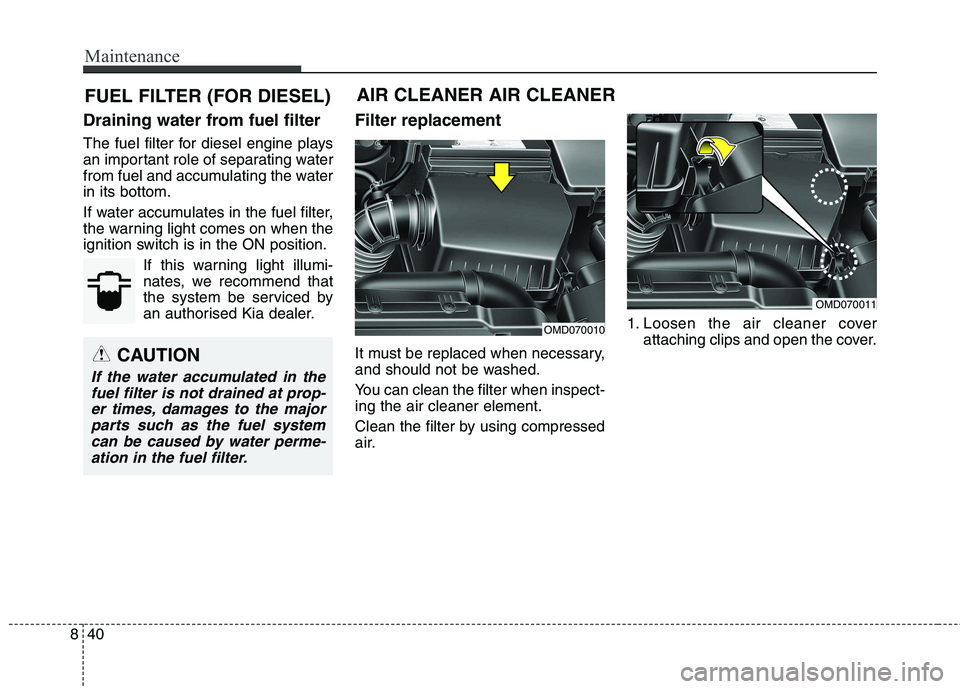
Maintenance
40
8
FUEL FILTER (FOR DIESEL)
Draining water from fuel filter
The fuel filter for diesel engine plays
an important role of separating water
from fuel and accumulating the waterin its bottom.
If water accumulates in the fuel filter,
the warning light comes on when the
ignition switch is in the ON position. If this warning light illumi-
nates, we recommend that
the system be serviced by
an authorised Kia dealer. Filter replacement
It must be replaced when necessary,
and should not be washed.
You can clean the filter when inspect- ing the air cleaner element.
Clean the filter by using compressed
air.
1. Loosen the air cleaner cover
attaching clips and open the cover.
CAUTION
If the water accumulated in the
fuel filter is not drained at prop-er times, damages to the major parts such as the fuel systemcan be caused by water perme-ation in the fuel filter.
AIR CLEANER AIR CLEANER
OMD070011
OMD070010
Page 696 of 723

8109
Maintenance
EMISSION CONTROL SYSTEM
The emission control system of your
vehicle is covered by a written limited
warranty. Please see the warranty
information contained in the Service
Passport in your vehicle.
Your vehicle is equipped with an emission control system to meet all
emission regulations. There are three emission control
systems which are as follows.
(1) Crankcase emission control sys- tem
(2) Evaporative emission control sys- tem
(3) Exhaust emission control systemIn order to assure the proper function
of the emission control systems, it is
recommended that you have your
car inspected and maintained by an
authorised Kia dealer in accordance
with the maintenance schedule. Caution for the Inspection and
Maintenance Test (With Electronic
Stability Control (ESC) system)
To prevent the vehicle from mis-
firing during dynamometer test-
ing, turn the Electronic Stability
Control (ESC) system off by
pressing the ESC switch.
After dynamometer testing is completed, turn the ESC system
back on by pressing the ESC
switch again.
1. Crankcase emission control system
The positive crankcase ventilation
system is employed to prevent air
pollution caused by blow-by gases
being emitted from the crankcase.This system supplies fresh filtered air
to the crankcase through the air
intake hose. Inside the crankcase,
the fresh air mixes with blow-by
gases, which then pass through the
PCV valve into the induction system. 2. Evaporative emission con-
trol System
The Evaporative Emission Control
System is designed to prevent fuel
vapours from escaping into the
atmosphere.
Canister
Fuel vapours generated inside the fuel tank are absorbed and stored in
the onboard canister. When the
engine is running, the fuel vapours
absorbed in the canister are drawninto the surge tank through the purge
control solenoid valve.
Purge Control Solenoid Valve (PCSV)
The purge control solenoid valve is
controlled by the Engine Control
Module (ECM); when the engine
coolant temperature is low during
idling, the PCSV closes so that evap-
orated fuel is not taken into the
engine. After the engine warms-up
during ordinary driving, the PCSV
opens to introduce evaporated fuel to
the engine.
Page 699 of 723
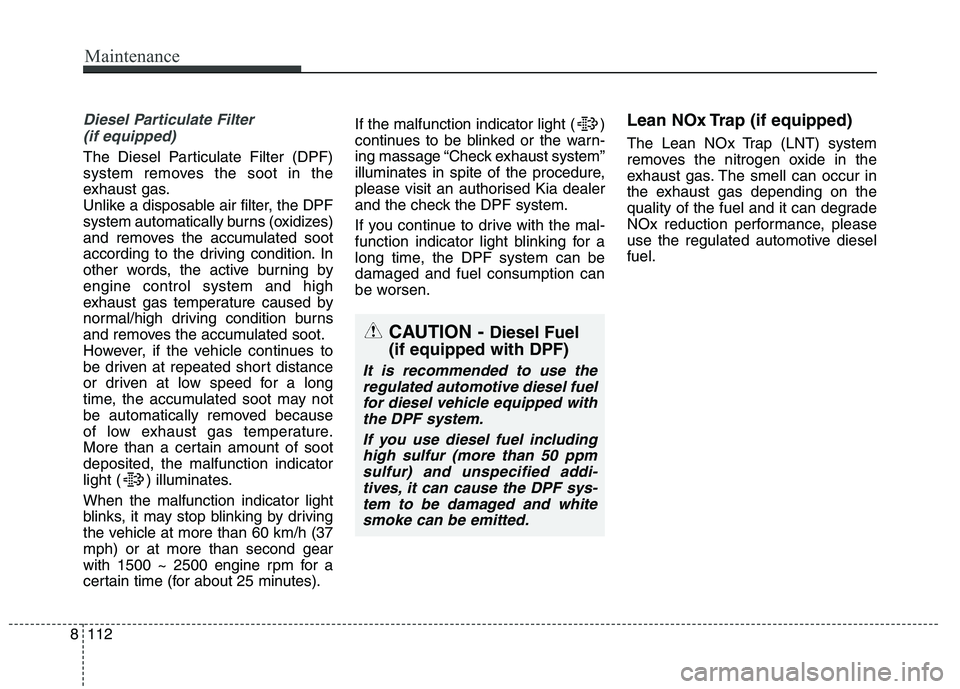
Diesel Particulate Filter (if equipped)
The Diesel Particulate Filter (DPF)
system removes the soot in the
exhaust gas.
Unlike a disposable air filter, the DPF
system automatically burns (oxidizes)
and removes the accumulated soot
according to the driving condition. In
other words, the active burning byengine control system and high
exhaust gas temperature caused by
normal/high driving condition burns
and removes the accumulated soot.
However, if the vehicle continues to
be driven at repeated short distance
or driven at low speed for a long
time, the accumulated soot may not
be automatically removed because
of low exhaust gas temperature.
More than a certain amount of sootdeposited, the malfunction indicator
light ( ) illuminates. When the malfunction indicator light
blinks, it may stop blinking by driving
the vehicle at more than 60 km/h (37mph) or at more than second gear
with 1500 ~ 2500 engine rpm for a
certain time (for about 25 minutes). If the malfunction indicator light ( )
continues to be blinked or the warn-
ing massage “Check exhaust system”
illuminates in spite of the procedure,
please visit an authorised Kia dealer
and the check the DPF system.
If you continue to drive with the mal-
function indicator light blinking for a
long time, the DPF system can bedamaged and fuel consumption can
be worsen.
Lean NOx Trap (if equipped)
The Lean NOx Trap (LNT) system
removes the nitrogen oxide in the
exhaust gas. The smell can occur in
the exhaust gas depending on the
quality of the fuel and it can degrade
NOx reduction performance, please
use the regulated automotive dieselfuel.
CAUTION -
Diesel Fuel
(if equipped with DPF)
It is recommended to use the regulated automotive diesel fuelfor diesel vehicle equipped with the DPF system.
If you use diesel fuel includinghigh sulfur (more than 50 ppmsulfur) and unspecified addi-tives, it can cause the DPF sys- tem to be damaged and whitesmoke can be emitted.
8112
Maintenance